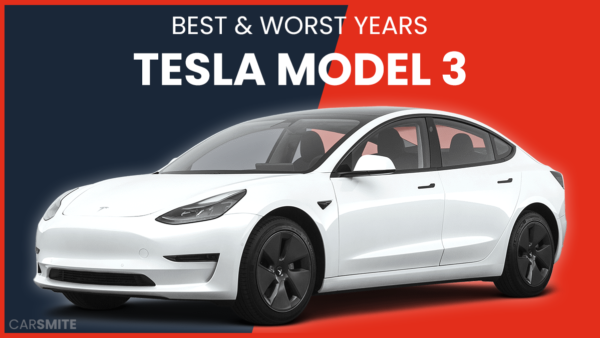In this guide, I’ll break down all Tesla Model S model years, revealing the top Tesla Model S years to buy and the worst years to avoid.
Our insights are backed by thorough analysis and data from reputable sources like the NHTSA, Consumer Reports, and Kelley Blue Book, providing a wealth of information on reliability, year-by-year owner satisfaction, and safety, ensuring our recommendations are sound.
Specifically, we’ll explore the performance and technical improvements of the Tesla Model S with common problems and recalls faced by different model years, helping you decide whether you’re buying new or used.
Let’s jump straight in!
Table of ContentsShow
Tesla Model S Generations
The Tesla Model S, introduced in 2012, revolutionized the electric vehicle market with its exceptional range, performance, and luxurious features.
As Tesla’s flagship sedan, it set new standards for electric mobility, offering cutting-edge technology, such as Autopilot, and a streamlined, aerodynamic design that contributed to its efficiency and speed.
Below is a table listing the production of the Tesla Model S from 2012 to the present.
| Generation | Years |
|---|---|
| 1st Generation | 2012-Present |
Substantial changes between generations, especially in technological and performance improvements and interior updates, might be the deciding factor for prospective buyers.
Tesla Model S Best, Neutral, and Worst Years
In our rankings and categorizations of the finest and worst years for the Tesla Model S, we consider a wide range of factors, including but not limited to:
- Owner-reported reliability (surveys)
- Annual maintenance costs
- Safety ratings
- Consumer Reports reliability scores
- Consumer Reports owner satisfaction scores
- NHTSA recalls, investigations, and complaints
- Edmunds owner ratings
- JD Power owner ratings
- Kelley Blue Book (KBB) owner ratings
- VehicleHistory owner ratings
- Cars.com owner ratings
Below is a summary chart that combines all the evaluations from the sources mentioned.

Next, we present a table categorizing all model years of the Tesla Model S into best, neutral, and worst years, offering a compact and brief comparison.
| Generation | Best Years | Neutral Years | Worst Years |
|---|---|---|---|
| 1st Generation | 2018 2019 2020 2023 2024 | 2021 2022 | 2012 2013 2014 2015 2016 2017 |
“Neutral Years” of the Tesla Model S do not have as many commendations as the top years but also do not have major issues like the worst years.
Certain factors, like NHTSA recalls, negatively affect a car’s overall ranking. A higher number of complaints and recalls indicates potential reliability issues affecting the vehicle’s classification.
Let’s explore the finest, neutral, and worst years.
Best & Worst Years for Tesla Model S 1st Generation (2012-Present)

Since its launch in 2012, the Tesla Model S has epitomized the evolution of the electric vehicle, melding luxury, performance, and zero emissions into a legendary sedan.
Over the years, Tesla has continually updated the Model S, enhancing its capabilities, increasing its range, and refining its technology to maintain its position as one of the most innovative electric vehicles on the market.
The Best Years: 2018, 2019, 2020, 2023, 2024
The prime years of 2018, 2019, 2020, 2023, and 2024 for the Tesla Model S are characterized by significant technological advancements and performance improvements, with fewer complaints.
The introduction of the Plaid model in 2021, continuing into 2023 and 2024, brought a tri-motor setup delivering a staggering 1,020 horsepower, capable of accelerating from 0 to 60 mph in just under 2 seconds.
These years also saw the rollout of improved battery technology, extending the range to over 400 miles on a single charge for the Long Range variants.
The interior saw a significant redesign, featuring a new 17-inch horizontal touchscreen, an improved Autopilot system for enhanced autonomous driving capabilities, and the addition of the yoke steering wheel.
Despite these advancements, it’s crucial to note that some owners have reported concerns with the yoke steering design and initial software bugs in the infotainment system. However, Tesla has addressed many of these issues through over-the-air updates.
The Neutral Years: 2021, 2022
For the Tesla Model S, 2021 and 2022 represent a period of transition and enhancement. These models introduced a substantial refresh of the Model S lineup, including updates to the exterior styling and a major interior overhaul.
The refresh introduced a more powerful and efficient heat pump, enhancing HVAC performance in various climates. The Plaid variant was announced, offering groundbreaking performance, though it was more widely available in 2022.
These years maintained high performance and range, with the Long Range model offering up to 405 miles per charge.
Issues during these years included initial developmental pains with the infotainment system due to the upgraded processor and occasional hardware-related recalls, such as those for the malfunction due to overheating CPU, loss of power steering, and diminished windshield defrosting.
However, these issues were relatively minor and addressed quickly, making these years an attractive option for those seeking the recent Model S features without the premium price of the newest models.
The Worst Years: 2012, 2013, 2014, 2015, 2016, 2017
The Tesla Model S years to avoid, from 2012 to 2017, while revolutionary, were plagued by a series of issues that impacted their reliability and owner satisfaction.
Electrical system problems were widespread, with numerous reports of defective infotainment systems and touchscreen displays, which are crucial for controlling most of the car’s functions.
Recalls during these years were substantial, addressing critical issues such as power steering assist failures due to gear housing corrosion, the unexpected activation of automatic emergency brakes, and autopilot failures.
Suspension problems were also reported, particularly with control arms and fore links, leading to additional recalls and safety concerns.
While these models set the foundation for future enhancements and remain a testament to Tesla’s ingenuity, the frequency of these issues makes them less reliable for potential owners looking for a used Model S.
See NHTSA 2012, 2013, 2014, 2015, 2016, 2017 Tesla Model S recalls and complaints.
Tesla Model S Resale Values
Discover the chart below, which shows the Tesla Model S’s standard resale values over time.

Conclusion
What is the finest year Tesla Model S to buy?
It’s relatively clear that 2018-2024 are the top and most reliable feature-rich Tesla Model S model years, offering the finest of Tesla’s innovations.
Conversely, 2012-2017 are the worst Tesla Model S years to avoid due to their higher incidence of reported issues and recalls.
Which year of the Tesla Model S do you consider offers the finest value for its cost?
Share your thoughts in the comments beneath!




